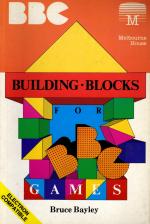
Argus Press
 1st November 1984
1st November 1984
Author: Dave Reeder
Publisher: Melbourne House
Machine: BBC/Electron
Published in A&B Computing 1.11
This book "for all BBC enthusiasts" according to the blurb, suggests that one way to make games writing easier is to have a set of pre-programmed modules to do the common jobs within a program. Then it goes on to show how the modules can be used to provide "exciting and original games". Far from being exciting and original, games like River Frog, Luna Lander, Simon and Brick Out are more likely to elicit a groan than a smile in this day and age.
The first section of the book on programming and how to manage a game writing project is fairly good and accurate. The diagrams are clear and the use of good programming structure is emphasised. I do wish though that authors wouldn't confuse "Top-Down design" with "Structured Programming", there is a difference. The last part of this chapter contains a procedure called "chexsum" which is a method of checking programs as they are input and seeing where any typing mistakes might be. This is a great idea for machines that have a poor error reporting system, but this cannot be said of the BBC or Electron machines. With these machines the procedure is almost redundant as the reports tell you a great deal more than a checksum ever could. It helps the writer however - each program is followed by the full "chexsum" list and by my quick calculation that takes up over twenty pages of the book!!
The next section contains three utility programs, a character definer, a sound definer and a background builder. The first two are both reasonable but are far less well organised and capable than a number of such programs that you have read in magazines. The character definer will give you the VDU 23 lines for the characters but will not allow any colour changing within a character. The sound aid allows you to redefine envelopers but only the pitch envelope section. This is probably because the amplitude envelope is fixed on the Electron, but it means that the program is less flexible than most others I have seen. The background aid is a very strange invention for developing DATA lines to be used to draw backgrounds in games.
The actual program modules themselves are a surprising collection, to say the least. They comprise modules to move a character around the screen, clear a message off the screen, build up a deck of cards, pick a card from the deck and build background from DATA lines. Apart from a machine code version of the move module, that is it - five modules. No mention of high score tables, multicoloured sprites, title screens, instruction routines, etc. The routines seem to work alright but they leave a great deal to be done by the programmer. In a matter of minutes I could produce a list of modules of far more value than these.
Even the author doesn't exactly use them extensively. Of the seventeen finished games in the book, five don't use any of the "building blocks" and only a couple use three of them at once. By far the most valuable is the movement procedure, which is called different names in some parts of the text! This is rather too little a core on which to base a book and, as such, I could only recommend it to those who are interested in having a collection of simple listings to type into their machine. Don't think that you will learn a great deal from doing so however, there is a very minimum of program documentation. Save your money.


